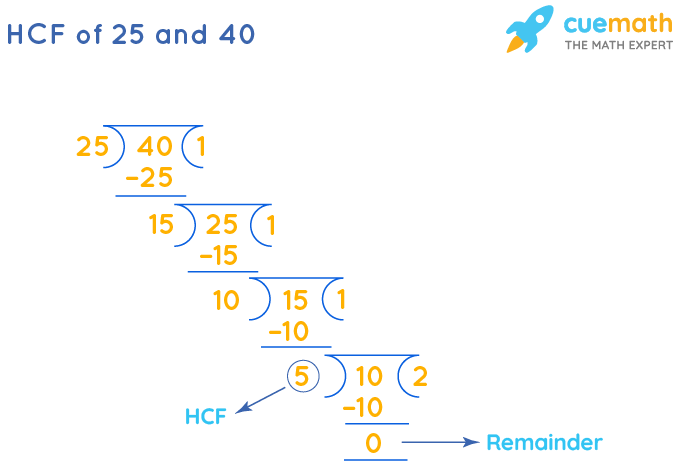HCF of 25 and 40
HCF of 25 and 40 is the largest possible number that divides 25 and 40 exactly without any remainder. The factors of 25 and 40 are 1, 5, 25 and 1, 2, 4, 5, 8, 10, 20, 40 respectively. There are 3 commonly used methods to find the HCF of 25 and 40 - long division, prime factorization, and Euclidean algorithm.
| 1. | HCF of 25 and 40 |
| 2. | List of Methods |
| 3. | Solved Examples |
| 4. | FAQs |
What is HCF of 25 and 40?
Answer: HCF of 25 and 40 is 5.

Explanation:
The HCF of two non-zero integers, x(25) and y(40), is the highest positive integer m(5) that divides both x(25) and y(40) without any remainder.
Methods to Find HCF of 25 and 40
The methods to find the HCF of 25 and 40 are explained below.
- Long Division Method
- Listing Common Factors
- Prime Factorization Method
HCF of 25 and 40 by Long Division

HCF of 25 and 40 is the divisor that we get when the remainder becomes 0 after doing long division repeatedly.
- Step 1: Divide 40 (larger number) by 25 (smaller number).
- Step 2: Since the remainder ≠ 0, we will divide the divisor of step 1 (25) by the remainder (15).
- Step 3: Repeat this process until the remainder = 0.
The corresponding divisor (5) is the HCF of 25 and 40.
HCF of 25 and 40 by Listing Common Factors
- Factors of 25: 1, 5, 25
- Factors of 40: 1, 2, 4, 5, 8, 10, 20, 40
There are 2 common factors of 25 and 40, that are 1 and 5. Therefore, the highest common factor of 25 and 40 is 5.
HCF of 25 and 40 by Prime Factorization
Prime factorization of 25 and 40 is (5 × 5) and (2 × 2 × 2 × 5) respectively. As visible, 25 and 40 have only one common prime factor i.e. 5. Hence, the HCF of 25 and 40 is 5.
☛ Also Check:
- HCF of 120, 144 and 204 = 12
- HCF of 403, 434 and 465 = 31
- HCF of 28 and 36 = 4
- HCF of 336, 240 and 96 = 48
- HCF of 4 and 5 = 1
- HCF of 170 and 238 = 34
- HCF of 145 and 232 = 29
HCF of 25 and 40 Examples
-
Example 1: For two numbers, HCF = 5 and LCM = 200. If one number is 25, find the other number.
Solution:
Given: HCF (y, 25) = 5 and LCM (y, 25) = 200
∵ HCF × LCM = 25 × (y)
⇒ y = (HCF × LCM)/25
⇒ y = (5 × 200)/25
⇒ y = 40
Therefore, the other number is 40. -
Example 2: Find the HCF of 25 and 40, if their LCM is 200.
Solution:
∵ LCM × HCF = 25 × 40
⇒ HCF(25, 40) = (25 × 40)/200 = 5
Therefore, the highest common factor of 25 and 40 is 5. -
Example 3: The product of two numbers is 1000. If their HCF is 5, what is their LCM?
Solution:
Given: HCF = 5 and product of numbers = 1000
∵ LCM × HCF = product of numbers
⇒ LCM = Product/HCF = 1000/5
Therefore, the LCM is 200.

FAQs on HCF of 25 and 40
What is the HCF of 25 and 40?
The HCF of 25 and 40 is 5. To calculate the Highest common factor of 25 and 40, we need to factor each number (factors of 25 = 1, 5, 25; factors of 40 = 1, 2, 4, 5, 8, 10, 20, 40) and choose the highest factor that exactly divides both 25 and 40, i.e., 5.
What is the Relation Between LCM and HCF of 25, 40?
The following equation can be used to express the relation between LCM and HCF of 25 and 40, i.e. HCF × LCM = 25 × 40.
What are the Methods to Find HCF of 25 and 40?
There are three commonly used methods to find the HCF of 25 and 40.
- By Long Division
- By Euclidean Algorithm
- By Prime Factorization
How to Find the HCF of 25 and 40 by Long Division Method?
To find the HCF of 25, 40 using long division method, 40 is divided by 25. The corresponding divisor (5) when remainder equals 0 is taken as HCF.
How to Find the HCF of 25 and 40 by Prime Factorization?
To find the HCF of 25 and 40, we will find the prime factorization of the given numbers, i.e. 25 = 5 × 5; 40 = 2 × 2 × 2 × 5.
⇒ Since 5 is the only common prime factor of 25 and 40. Hence, HCF (25, 40) = 5.
☛ What are Prime Numbers?
If the HCF of 40 and 25 is 5, Find its LCM.
HCF(40, 25) × LCM(40, 25) = 40 × 25
Since the HCF of 40 and 25 = 5
⇒ 5 × LCM(40, 25) = 1000
Therefore, LCM = 200
☛ HCF Calculator
visual curriculum
